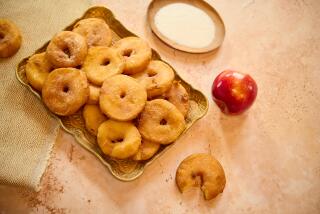To the Letter of the Law
Like a saltine stripped of all its luxuries, Passover matzo is made only of flour and water: no shortening, no salt and especially no yeast.
It sounds simple. It isn’t.
Consider that the Passover matzo maker has just 18 minutes--not a minute more--to complete the process of making the unleavened bread from start to finish. That figure is the result of rabbinical calculations recorded in the Shulchan Aruch, the primary compilation of rabbinical law, which says the process of leavening begins in the time it takes to walk a Roman mile.
To determine just how long it takes to walk a Roman mile, several designated walkers were gathered for a rabbinical experiment long ago, a holy race of sorts. The person who walked the distance the fastest made it in 18 minutes. That became the time limit for matzo makers.
It might help to know that a Roman mile is 2,000 cubits. And what’s a cubit? (Sorry, Mr. Cosby.) A cubit is the length of the forearm from elbow to fingertips or half the length of a pace (a mile was 1,000 paces, mille passuum, and hence 2,000 cubits). And you thought the metric system was confusing.
Beyond the time limit, the flour used for Passover matzo must be monitored by a rabbinical authority from the time it is ground to be sure that it doesn’t come into contact with water. If even a little water touches the flour, fermentation could begin too early.
In addition, the Passover matzo maker must keep the environmental conditions of the bakery under tight control. With this in mind, certain provisions were laid out in the Shulchan Aruch to prevent any leavening during the production of matzo. These measures are illustrated in the steps taken at Yehuda Fishkind’s Baltimore Matzo Bakery, which produces shmura matzos, the most rabbinically correct matzos there are. Fishkind’s bakery is one of just eight bakeries in the country that produce handmade shmura matzos; considering the rules, it’s no wonder there aren’t more.
If flour is destined for shmura (watched or guarded) matzo, the grain must be monitored by a rabbinical authority not just from the time it is milled but from the time it is harvested. This means Fishkind has to pick the grain for his matzo at just the right time. If harvested too soon, the grain will not be ripe. And if the grain is allowed to mature too long on the plant, it will crack and begin to sprout, meaning it would be a little too eager to ferment--great for making beer but too far gone for matzo.
When the best grain is selected and the harvesting window is determined, the reaping begins. Then the shmuring really begins. The wheat has to be constantly watched and protected from moisture. Getting the kernels of wheat off the plant is just the first step. Fishkind tells of his first year in business, when the harvest was on Sunday but the grain could not be packed until the next day.
“Since the grain could not be locked up for the night,” Fishkind says, “I stayed with the grain [in the field] to make sure it wasn’t tampered with.” The first year’s batch was truly guarded matzos.
Next the grain is sifted and packed in waterproof sacks and stored until it is ready to be ground. When the grain finally is ground, special milling procedures have to be followed to minimize the heat of grinding. Most flour is moistened to keep it cool during milling, but Passover flour must not be moistened before the dough is mixed. Instead, the process is slowed way down to allow any heat generated by grinding to dissipate without harming the grain. As an extra precaution, Baltimore Matzo Bakery has a stone mill; stone is a poor heat conductor, so the grinding imparts as little heat as possible.
There are still more leavening prevention measures outlined in the rabbinical code. No windows are allowed in the bakery or grain storage areas because heat from the sun’s rays could taint the flour and dough. And the water used to make the matzo must be cooled overnight to disperse residual heat. Since the Shulchan Aruch was written before the development of insulation, no provisions for it is made in bakery construction, but amendments may be forthcoming.
Finally, after all these precautions, the matzo may be made--with the full 18 minutes still on the clock.
So it begins at the Baltimore Matzo Bakery, with a specially built hearth oven, a well-sanitized work space, a well-trained staff and some of the most closely watched flour in the world.
First the bakers add the water, adjusting the amount depending on the percentage of moisture in the flour and the humidity in the air. And since there are prohibitions against adding flour after the first water has been added, the liquid has to be added gradually. With no adjustments allowed, these guys are working without a net.
Next comes working the dough (a task the kneader can handle in 20 seconds), rolling out the individual matzos into the traditional disk shape, perforating the matzos to release any air trapped in the dough (further vigilance against leavening) and baking in an extremely hot oven (750 degrees at Baltimore Matzo Bakery).
The result is a crisp, lightly browned certified matzo.
Then the bakery has to be thoroughly cleaned of any residual dough (in as little as 10 seconds) and the next batch begins. Any dough from the previous batch, although far from unhealthful, would contaminate the next batch of matzo in terms of leavening.
The shmura matzos that come out of the oven are the unleavened bread most in compliance with rabbinical law. Guarded matzos may also be made by machine, but the handmade ones are preferred by the more Orthodox Jews. Some eat only shmuras during the whole of Passover. Some eat this well-watched bread only on the holiest night of the holiday, the Seder. Regular Passover matzo is, of course, acceptable during the entire observance. But if you want matzos like they made in the old days, handmade shmura are the ones to watch.
MATZO
1/4 cup cake flour
2 tablespoons water
Place pizza stone in oven and heat to 450 degrees.
Mix flour and water just to combine. Roll out dough in very thin sheet. Perforate surface all over using fork. Cut edges, if desired, to make rectangle shape. Place matzo on heated pizza stone and bake until very lightly browned, 4 to 6 minutes.
Makes 1 matzo.
Each matzo contains about:
99 calories; 1 mg sodium; 0 cholesterol; 0 fat; 21 grams carbohydrates; 2 grams protein; 0.06 gram fiber.
MATZO ASHIRAH
(Rich Matzo)
1 cup cake flour
1 egg, beaten
1/4 cup apple juice
1/8 teaspoon cinnamon
Place pizza stone in oven and heat to 450 degrees. Mix flour, egg, apple juice and cinnamon just to combine and roll out into very thin 7 1/2-inch rounds. Perforate surface of rounds all over using fork. Place 1 matzo on heated pizza stone and bake until very lightly browned, 4 to 6 minutes. Repeat with remaining matzo.
Makes about 3 matzos.
Each matzo contains about:
166 calories; 22 mg sodium; 71 mg cholesterol; 2 grams fat; 31 grams carbohydrates; 5 grams protein; 0.12 gram fiber.
CHICKEN SOUP WITH MATZO BALLS
CHICKEN SOUP
1 (3 1/2- to 4-pound) chicken, cut into pieces, most fat removed and reserved for matzo balls
3 quarts water
3 carrots, cut in medium dice
2 onions, cut in small pieces
3 celery stalks, sliced thin
2 turnips, cut in medium dice
Salt
Ground black pepper
MATZO BALLS
4 eggs
1/2 cup water
6 tablespoons melted chicken fat (from chicken)
Salt
Ground black pepper
1 cup matzo meal
CHICKEN SOUP
Place chicken and water in 5-quart stock pot, bring to boil, then reduce to simmer. Skim foam off surface as it appears. After about 15 minutes, add carrots, onions, celery and turnips. Simmer, covered, 4 to 6 hours. Season with salt and pepper to taste. Remove bones and skin from chicken pieces.
MATZO BALLS
Beat eggs until just combined. Add water, chicken fat and salt and pepper to taste. Slowly add matzo meal, stirring until it is well mixed. Cover and refrigerate about 1 hour.
Bring large pot of water to boil. Mold heaping tablespoon of batter into ball in your moistened hands. Drop ball into boiling water. Repeat procedure until batter is used up. You should have enough to make about 24 matzo balls. Boil matzo balls about 30 minutes.
Serve matzo balls in chicken soup, 2 to 3 per bowl.
Makes 10 to 12 servings.
Each of 12 servings contains about:
315 calories; 161 mg sodium; 157 mg cholesterol; 19 grams fat; 20 grams carbohydrates; 21 grams protein; 0.26 gram fiber.
MATZO MEAL PANCAKES WITH CHEESE AND GREEN ONIONS
6 eggs
1 1/2 cups water
1/2 teaspoon salt
1 1/2 cups matzo meal
1 cup cheddar cheese, finely grated
1 1/2 cups green onions, sliced
Oil
Sour cream, optional
Mix eggs, water and salt in bowl. Slowly stir in matzo meal. Allow to thicken. (By letting it sit? for how long? kg) Fold in cheese and green onions.
Heat oil in skillet over medium heat. Pour about 3/8 cup of batter into skillet and allow 1 side to brown. Flip pancake and press top down with spatula to ensure even cooking. When both sides are nicely browned, place pancake on paper towel to absorb oil. Repeat with remaining batter. Serve pancakes with sour cream, if desired.
Makes 6 (4-inch) pancakes.
Each pancake, without sour cream, contains about:
294 calories; 377 mg sodium; 232 mg cholesterol; 13 grams fat; 47 grams carbohydrates; 15 grams protein; 0.33 gram fiber.
More to Read
Eat your way across L.A.
Get our weekly Tasting Notes newsletter for reviews, news and more.
You may occasionally receive promotional content from the Los Angeles Times.








